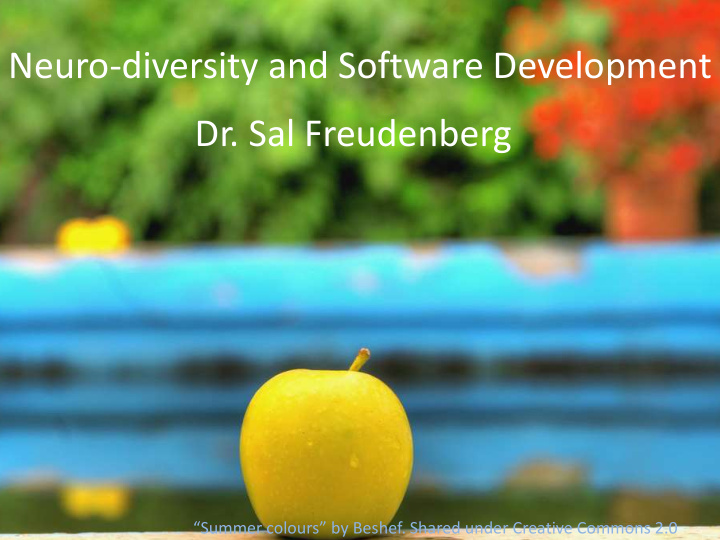



Neuro-diversity and Software Development Dr. Sal Freudenberg “Summer colours ” by Beshef. Shared under Creative Commons 2.0
Dr. Temple Grandin HBO movie trailer Temple at Google 1 Temple at Google 2
Empirical evidence • Autism occurs more often in families of physicists, engineers and mathematicians Baron-Cohen et al (1998) • Mothers of autistic kids are more likely to work in highly technical occupations - Windham et al (2009) • Significantly more autism in children in IT rich regions - Roelfsema et al (2011) • ASD students more likely to choose STEM subjects – Wei et al (2003)
Different types of Thinker
Historical Studies of Programmers “My mouse isn’t working right” by Nina Matthews Photography. Shared under Creative Commons 2.0.
Chunking “Lost Battle?” by Elvind Barstad Waaler, shared under Creative Commons 2.0
Beacons “Peggy’s Lights Up” by Dennis Jarvis via Creative Commons 2.0
Schema “Time passages” by Robert S. Donovan. Shared under Creative Commons 2.0
BEGIN Sum := 0; Count := 0; REPEAT READLN(number); IF number <> 99999 THEN BEGIN Sum := Sum + number Count := Count + 1 END; UNTIL number = 99999 ………………
BEGIN Sum := 0; Count := 0; REPEAT READLN(number); IF number <> 99999 THEN BEGIN Sum := Sum + number Count := Count + 1 END; UNTIL number = 99999 ………………
Hierarchical Decomposition “58.365” by Romana Klee. Shared under Creative Commons 2.0
Formal Representations *
Informal Representations
Tacit knowledge Image by epSos.de shared under Creative Commons 2.0
Temple Grandin
Preparation, incubation, illumination, verification* *Wallis (1926)
Luminarium
Cara Turner, 2014
Distributed cognition* *”Cognition in the Wild” by Ed Hutchins
Peripheral Awareness
Legitimate Peripheral Participation* *Lave & Wenger
Language and Communication Social and Emotional Flexibility of thought
Sensory Processing Disorder “Vintage Scales” by Kool Cats Photography. Shared under Creative Commons 2.0
One size doesn’t fit all “Newsroom panorama” by David Sim. Shared under Creative Commons
Thank you
“Autism occurs more often in families of physicists, engineers, and mathematicians”, Baron -Cohen S., Bolton P., Wheelwright S., Scahill V., Short L., Mead G., and Smith A. in Autism, 1998, p.296-301 “Autism spectrum disorders in relation to parental occupation in technical fields”, Windham GC1, Fessel K, Grether JK., Official Journal for the International Society for Autism Research, 2009 Aug;2(4), p.183-91. “Are autism spectrum conditions more prevalent in an information -technology region? A school-based study of three regions in the Netherlands”, Roelfsema, Martine T.; Hoekstra, Rosa A.; Allison, Carrie; Wheelwright, Sally; Brayne, Carol; Matthews, Fiona E. and Baron-Cohen, Simon (2012). Journal of Autism and Developmental Disorders, 42(5) pp. 734 – 739. “The Autistic Brain: Thinking across the spectrum”, Dr. Temple Grandin and Richard Panek. Published by Houghton Mifflin 2013. “The magical number seven, plus or minus two: Some limits on our capacity for processing information”. Miller G.A. (1956), Psychological Review 63(2): 81-97. “Perception in chess”, Chase, W. and Simon, H.A., (1973). Cognitive Psychology 4, p.55 -81. "Chunks: A Basis for Complexity Measurement”. J.S. Davis (1984), Information Processing and management, Vol. 20, nos. 1-2, p.119-127. “Towards a theory of the comprehension of computer programs”, Brooks, R. (1983), International Journal of Man-Machine Studies, 18, p.543-554. “Software Design: Cognitive Aspects”, Detienne, F (2002). Published by Springer.
“Characterizing the program design activity, neither strictly top - down nor globally opportunistic” – Davies (1991). Behaviour and Information Technology 10(3). “Developing the atttributes of medical professional judgement and competence: a review of the literature”, Eraut, M. and Du Boulay, B. (2000), Cognitive Sciences Research Paper 518, University of Sussex. “When mental models go wrong: co - occurrences in dynamic, critical systems”, Besnard, D., Greathead, D., Baxter, G. (2004). International Journal for Human-Computer Studies 60. p117-128. (Kegworth air disaster). “Formality in sketches and visual representation: Some informal reflections”, Blackwell, A.F., Church, L., Plimmer, B. and Gray, D. (2008) Workshop at VL/HCC 2008, p.11-18. “Mental imagery in program design and visual programming”, Petre M. and Blackwell (1999), A.F., International Journal of Human-Computer Studies 51(1), p.7-30. “The Art of Thought”, Wallas, G., (1926), Published by Jonathan Cape. “Cognition in the Wild”, Ed Hutchins (1996), Published by MIT Press. “Pair Programming and the re - appropriation of individual tools for collaborative software development”, Bryant, S., Romero, P., Du Boulay, B., (2006), Proceedings of the 2006 conference on Cooperative Systems Design, p.55-70. “Situated Learning: Legitimate Peripheral Participation”, Lave, J. and Wenger E., (1991). Published by University of Cambridge Press.
Recommend
More recommend